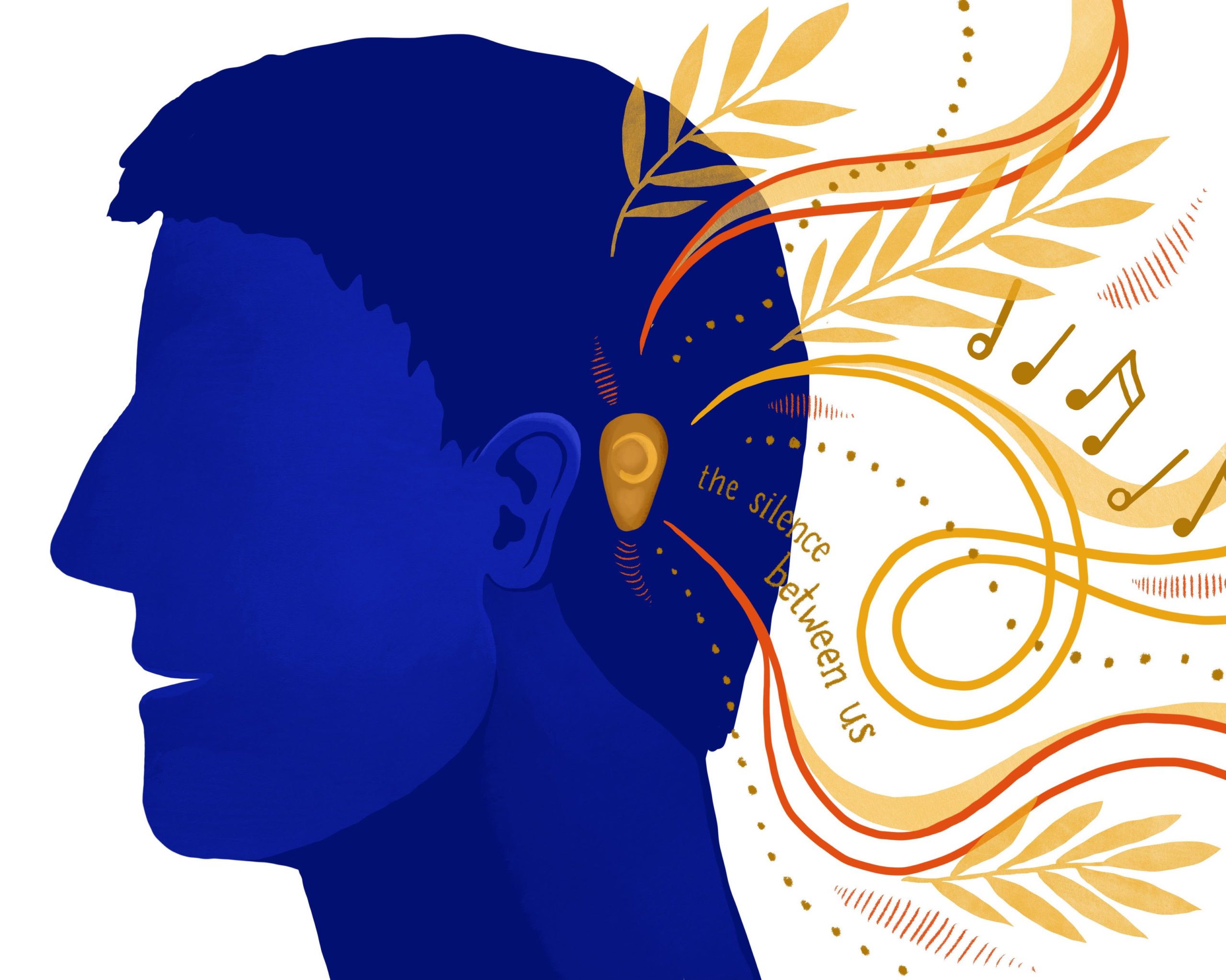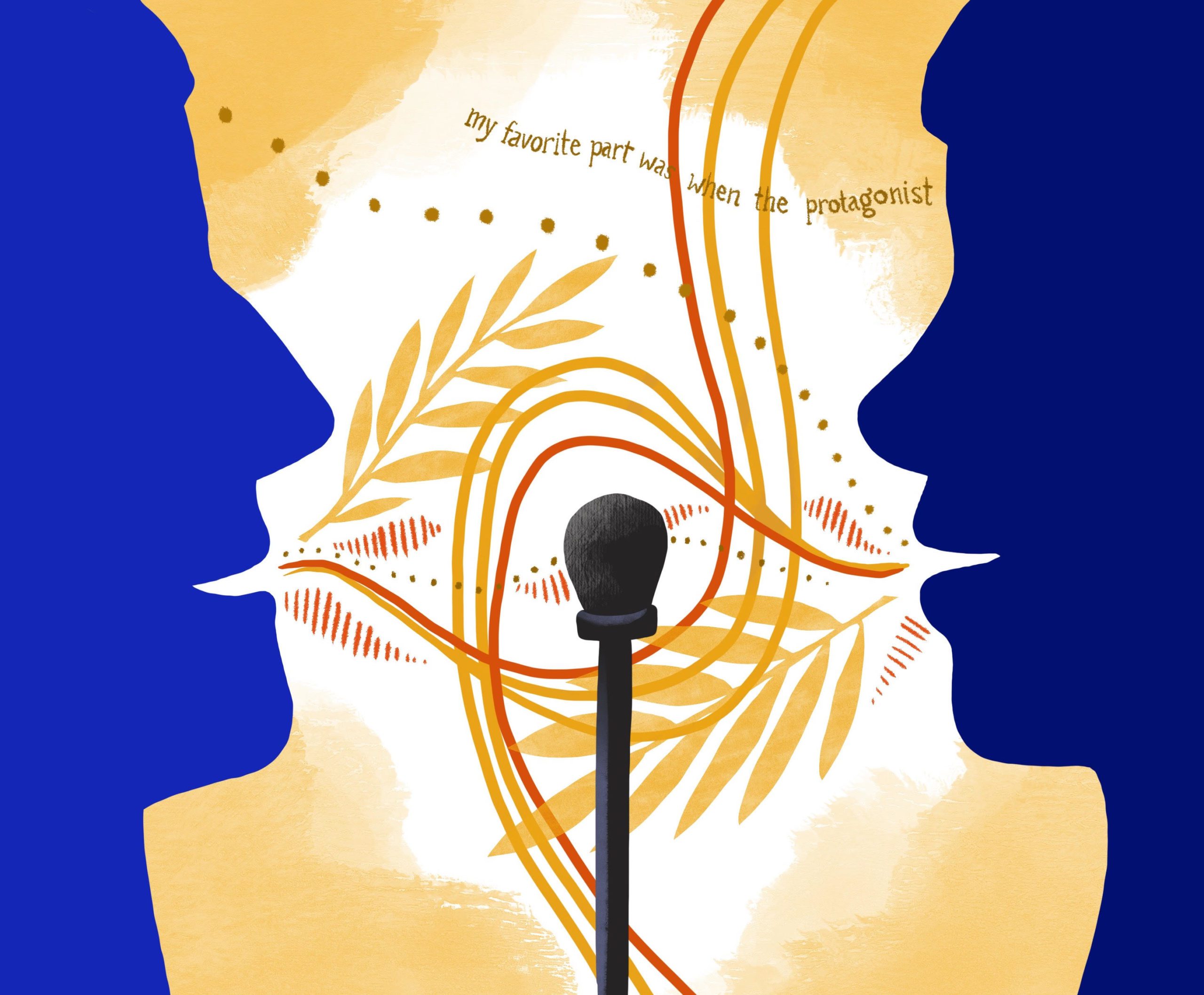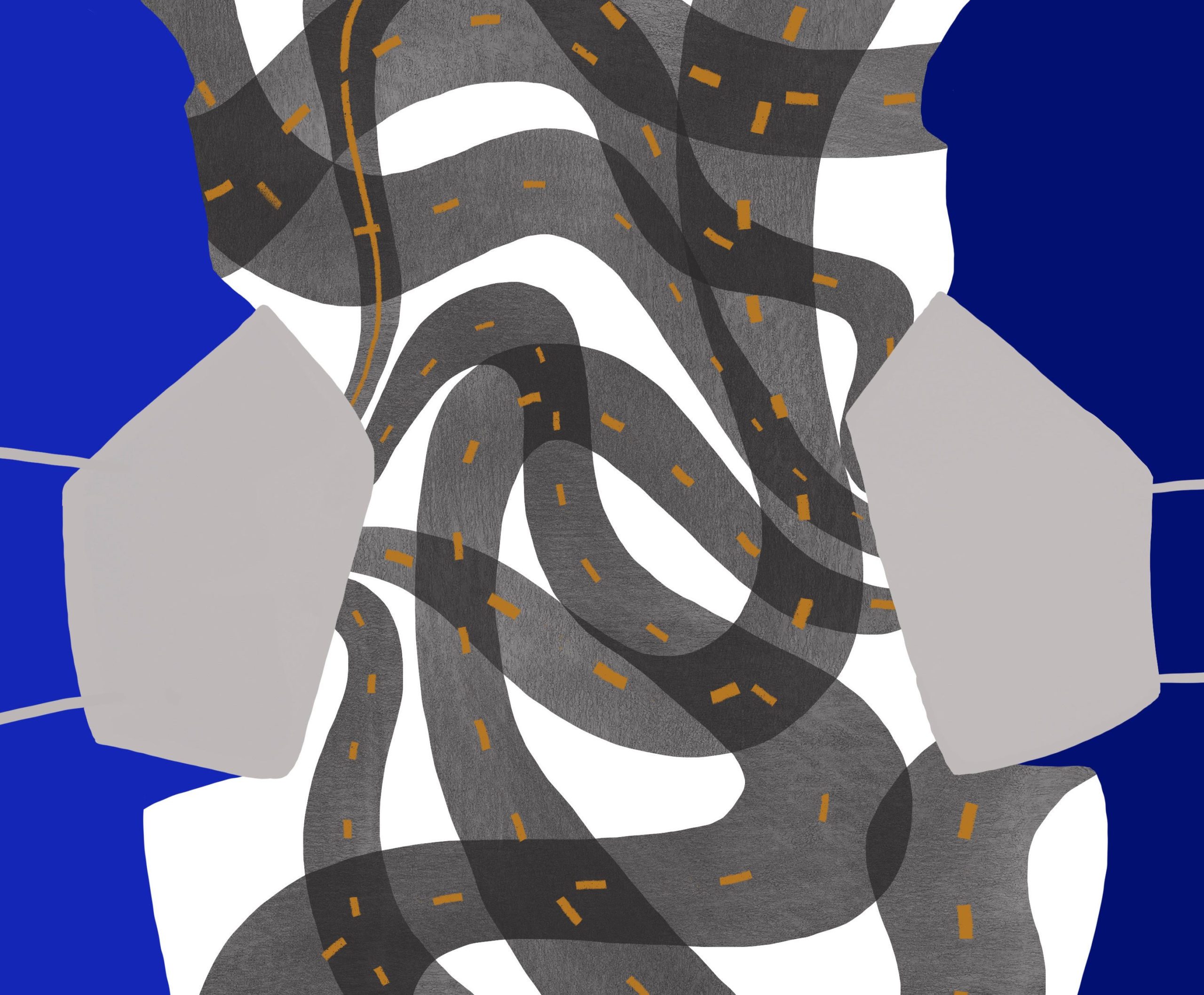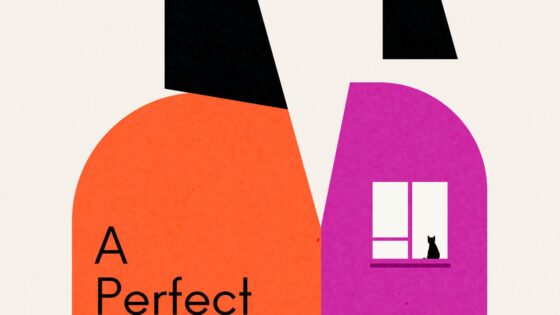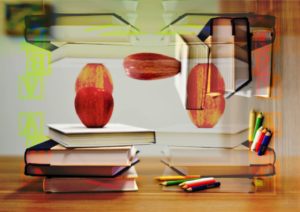
Until this year, it had honestly never occurred to me to use a microphone in my classroom. Lipreading, along with my hearing aids, had always been enough.
When we returned from distance learning to the classroom, I eagerly set up my classroom again. I put up posters on the walls and arranged the tables and chairs into a large rectangle, so that all students would face each other. Though the hallways were at a fourth of normal capacity, it was shocking to be around so many people once again. I had both shots—Pfizer—and soothed my animal terror with reassuring thoughts of a vigorous immune response. I was grateful for my state’s mask mandate to provide another layer of protection against COVID-19. That day’s cohort of students walked in, took their seats, and it seemed close to normal. Except for the masks.
Each student’s face was a monolith. When I called on students, I understood that they were talking, but exactly what they said was like a radio playing in a car winding around a mountain road. Without lip reading, student’s speech I made an effort to identify fuzzy words, growing increasingly frustrated and exhausted. Clear masks would be costly to distribute to my 125 or so students. AI generated captions often missed the discipline-specific words I most needed clarified. Lip reading, one of my most important tools, became useless in the face of the mask’s blankness.
For almost my whole life, at every age, I had different hearing aids. As I grew up, the technology improved. With each new set, I’d think, these are incredible, I wish I had them sooner, I could have heard so many more sounds.
I’ve worn behind-the-ear hearing aids since I was 18 months old, and have had several surgeries to install prosthetic plastic bones in my ear. I’ve got a fairly inconspicuous Oticon behind-the-ear aid on the right and a Bone Anchored Hearing Aid (BAHA) on the left. The BAHA is a recent addition, and an obvious one. It looks like a sci-fi spaceship roughly the size of a quarter. Strangers assume it is a cochlear implant, based on where the BAHA crouches down on its haunches against my skull. Rather it’s a magnetic bone-conducting computer that pipes language and music and podcasts into my brain.
The cyborg Jillian Weise, a poet whose work focuses on crip consciousness, declares “The victory of finally saying: ‘Oh, I really am a cyborg.’ My leg is a computer I have plugged into walls before to get a charge. Ontologically, this is different than a non-cyborg.” I feel particularly drawn to the identifier cyborg with my BAHA, though it is certainly not the first technology I have integrated into my body. From vaccines to prosthetic middle ear bones, my body is constructed.
People often ask me to compare my hearing to theirs. How does the world sound to me? They wonder what I am missing. This reaction is cultivated by the media that shows one kind of hearing experience: the viral video of a Deaf child hearing for the first time. Disability culture calls this the crip hero trope—the idea that what can be done “normally” for able-bodied people is extraordinary for disabled people, and thus a source of inspiration. There are many of these videos circulating online, often as compilations or segments on feel-good TV news. AJ096 writes in the comments of one such compilation video of babies experiencing cochlear implant activations. One commenter writes: “As someone dealing with bad depression, i like to watch these videos once in a while to remind me to be grateful of what i have and not lose the value of life.” Another says, “I am sobbing watching this, we take so much for granted in this world. . . . God bless these people who can make this happen they are angels.” Non-disabled people are encouraged to look at these kinds of videos and feel grateful for their abilities. They pity disabled folks, and project on them a vision of their own lives, but diminished: no listening to favorite songs, no laughing with friends late at night, no watching movies in theaters.
The videos smack of faith healing. Cochlear implants are shown as a cure for hearing loss, and all emotions are reduced down to the joy and awe from seeing a miracle. The restoration of the body through the transmutation of faith is played as evidence of God.
I don’t want their pity and I don’t want to be cured. I dance to my favorite songs, I share inside jokes with my friends, and I watch tons of movies! Hearing loss has shaped me. There will be no cure, only fluctuation in abilities, and technological advancements. And my cyborg technology is really cool.
Once, at dinner with a new friend, she declared that she couldn’t imagine her life without hearing. It would be so awful! That moment is one that I’ll remember for the rest of my life: my blood boiling, her undisturbed face, my shame at having to bring up my humanity, and my enraged silence. She couldn’t imagine the richness of my life, only constructed a pitiful collage of isolation and dullness. While this incident stands out in my memory, this is not the only time someone has said—to my face—that they wouldn’t want to be Hard of Hearing like me.
There are the practical advantages: upstairs neighbors whose heavy footsteps can’t be heard, annoying bugs and barking pets without any sound, and teachers’ boring lectures inconspicuously switched off. The supplemental strategy of lip reading makes me an attentive and active listener. At the local theater, I get front row tickets, in the accessible row. I find solidarity in the struggles of disabled folks as well as other marginalized groups. It was one of the first ways society told me I was outside.
In elementary school, kids would notice my hearing aid molds and ask “Do you have erasers in your ears?” I wanted them to be jealous of my machines. My mom said they were each worth as much as a diamond ring. My little diamond rings, one in each ear. So I fibbed, trying to whip the kids up in a frenzy over the thought of a little radio playing whenever I wanted, for only me to hear. Matt, another Hard of Hearing student, whose father earned way more money than my dad and so had top of the line hearing aids, was startled to learn he lacked what another company had.
Now decades later, technology has made my boastful lie honest. My new BAHA is bluetooth-enabled. I stream music straight into my brain—without headphones, no one the wiser. My BAHA has multi-directional functions. The microphone zeros in on whomever is talking, amplifying their voice. In a crowded restaurant, my BAHA excludes the background din and focuses on the person across the table from me. During a movie, my BAHA switches effortlessly between human voices and music, which requires a broader range of sounds. The major downside is that it is attached with a magnet. I lose it in the couch pillows, on the metal frame of my car as I slide into the seat, anywhere where it can be knocked off. I nicknamed the BAHA “Bruce Nuisance,” a malapropism of performance-artist Chris Burden’s name and the frustration the little machine inspires.
I’ve largely considered my identity as a disabled person as secondary, even tertiary. I’ve shrugged off my hearing as insignificant and unremarkable. Perhaps this is a kind of defensiveness: hearing aids tend to call up an image of grandma straining, not a Millennial with a full head of hair only barely starting to gray. Perhaps importance is determined by a sense of community and collective struggle for civil rights. I have my synagogue and my transmasc support groups; I consider being Jewish, transgender, and queer to be my primary identities. Other than a brief stint forming a club for disabled students at my college, I have spent very few hours in the company of other disabled folks.
I was an ADA child, the first generation to benefit from the landmark 1990 law providing disabled people robust legal protections against discrimination. In education, this meant mainstreaming students as much as possible, placing us in “the least restrictive environment,” rather than segregated schools for the Deaf. My parents fought tenaciously and lovingly for me to receive Deaf and Hard-of-Hearing Services (DHH) from the Los Angeles Unified School District. They wanted me to have the equal opportunities the law promised, to be prepared as any other non-disabled child entering kindergarten.
There is a picture of me from that time: a toddler in a yellow shirt, blue overalls, straight red hair and a look of concentration as I mold a ball of dough over a glass mixing bowl. Next to me, my first DHH teacher, a white woman with curly brown hair, stands there like a pillar I could lean on. She taught me to name the new sounds my hearing aids brought me: refrigerator hum, flour pour, human voice.
From then on, I had DHH teachers to support my learning. One taught me lip reading and phonics, another worked on smoothing out my speech, another was probably wonderful but had the misfortune of meeting me in my angsty teen years. Each sought to help me fit into mainstream classes as much as possible, and I excelled at school. The best compliment I could receive during this time was, “I didn’t even know you’re hearing impaired!”
My parents never stopped advocating for me. In elementary school, my mom met with my teacher at the start of each school year in order to educate her on how to best accommodate my hearing needs in class. Once, when a teacher refused to wear a microphone compatible with my hearing aids, my parents pressured the school until the teacher relented and complied. Nothing will be done, my mom assured me, unless I speak up for myself.
I enrolled in graduate school in 2011, having decided to put my BA in English to work and become a high school teacher. Right away, I sought out the Disability Resource Center, as I had done in my undergrad experience. The Director described the accommodations available to me as a graduate student. I asked what support the DRC had for me in my student teaching classroom. They didn’t really, the Director admitted, but she could put me in touch with an alumnus who was Deaf in one ear. I hoped our conversation would empower me and help me build a toolbox of strategies to adapt my own classroom to my needs.
The alumnus’s voice on the phone was warm and kind. I thanked him for taking the time to speak with me, and we chatted about the weather in Oakland. I was eager to dive into his experience. Sheepishly, he admitted he was no longer teaching.
“After about 8 years in the classroom, I went back to school and got my JD. It is much easier to be a lawyer.”
I was stunned. This was not at all how I anticipated this call going.
“I loved the kids, but it was so hard,” the alumnus said. “If I was at the board, I couldn’t hear the kids behind me. Classroom management was hard that way. They would say things behind my back, and once I turned around, there they were, laughing.”
He shared some of the ways he tried to shape the classroom into an accessible space. My nervous enthusiasm turned to dispirited quiet as he spoke.
“I walked around the room, you know, whenever a student spoke, so that I could be close enough to hear what he was saying.”
“What other accommodations did you use?” I asked.
“There weren’t too many, that’s why I left. I was always straining to hear. You know, there’s a lot of emphasis on accommodating students, but there’s very few resources on supporting teachers. I’m sorry. I wish I had better advice for you.”
The only Deaf teacher the Disability Resource Center could come up with was a guy who was so frustrated by the lack of accessibility that he left the teaching profession all together!
I thanked him for his time. The conversation completely deflated me.
Further research on the internet came up mostly with how to become a teacher of the Deaf and Hard of Hearing or how to accommodate Hard of Hearing students in your class. In my classes, the course readings never addressed the possibility of a teacher requiring accommodations on the job. Without a mentor and resources, I struggled not just with learning to plan lessons or grade papers, but with communicating with my students. To ask students to repeat themselves, sometimes several times, lessens the relationship-building at the heart of good teaching. Day after day, I would come home exhausted from the effort to understand my students’ speech.
This failure to imagine disabled teachers creates a bottleneck of discrimination at the pre-service level. If graduate schools are ill-prepared to serve disabled teachers-in-training, they create an environment of unequal opportunities. Few like being a pioneer. When we don’t see others who experience the world like us, it is difficult to imagine the world otherwise and even more difficult to be part of the struggle to make that change happen. Accommodations in the graduate classrooms remove unnecessary obstacles to the completion of coursework needed for a license. A toolbox of accessibility strategies helps create successful student teaching experiences. Inclusive, welcoming graduate programs that explicitly highlight the experiences of disabled grad students and the school’s efforts towards accessibility would certainly lead to an increase of disabled teachers.
I remained in the teacher credentialing program because I liked teaching. In the years since graduation, I have taught in private and public schools. I have now surpassed the alumnus’ eight years in the classroom. I’ve developed a bunch of strategies to make my job more accessible: arranging the desks to maximize lipreading ability, talking openly about my hearing loss, and asking students to accommodate me by speaking louder and repeating what they said. I teach students literature by disabled writers and lead discussions on creating a more inclusive, accessible classroom for all.
Even so, it is still difficult to support students who speak softly. Once, when a freshman developed a pattern of late and missing assignments, I asked her to stay after class to discuss her work. I started the conversation by praising the quality of her contributions to class as well as her creativity and skill in drawing. “Yet, I’ve noticed that you’re not turning in your homework and assignments. Is that accurate?” She nodded her head. “Why do you think that is?“ I said. She responded quietly and though I concentrated on deciphering her words —something about being tired, taking care of a sibling, sick with I couldn’t catch what, at night while her mother worked. Not hearing her clearly made me doubt what I had heard and which was the best way to help a student get back on track. I should have asked follow up questions, “What do you need to do to improve your learning? How do you think I can support you while you meet this challenge?” But I didn’t, and saw this student receive failing grade after failing grade through the rest of the year, and then, looking on from the sidelines, her sophomore year.
Nor did I see colleagues skillfully modeling teaching with hearing loss. I couldn’t have been the only one in the three schools I’ve worked at. No one spoke about how teachers struggled to hear kids, or what they did to hear those kids. Maybe they didn’t. Maybe they pretended like they could hear, or they just didn’t call on those kids, or they relied on lecture, or their stand-offish affect was an attempt to cloak their disability.
I was substitute teaching when the lockdowns began in March 2020. Sub opportunities dried up. But then, in February 2021, a long-term English teacher substitute position opened up in a public high school on the outskirts of the metropolitan area. I interviewed, and got the job.
At first, the school was still doing distance learning. It was a difficult time to jump into a new environment. I stared at my screen, a matrix of rectangles, each representing a student who was, theoretically, in the class. Only a couple of students in each period turned their cameras on and participated. Their voices, however, came over loud and clear. My computer’s speakers could be adjusted, raising the volume of a student’s voice as loud as I needed. AI real-time captioning provided some clarification. How exhausted I had been in the classroom, focusing on deciphering the noises! I didn’t know how much easier amplification would make my work; it had never been suggested; it never even occurred to me.
When we returned in the spring to in-person classes, I understood the access I had lost. There was no longer a knob to turn up the volume. There were no longer captions. In fact, the masks muffled students’ voices, dampening even the strongest speakers. It was exhausting: the focus required to decipher words at the edge of my understanding.
Since I was a substitute, employed by an agency rather than the school district itself, I didn’t want to ask for equipment. Instead, I purchased a small lavalier mic, connected it to my computer, and placed it, clipped to a roll of blue painter’s tape, on a stool in the middle of the rectangle of desks. Maybe it was better than nothing, but it wasn’t much. The mic wasn’t that powerful, and it was a poor replacement for lip reading. The accuracy of auto-captioning was less than ideal. The AI program captured the gist of student speech, but sometimes dropped a consonant or syllable and I had to interpret or ask the original speaker to speak up again, this time louder.
It was difficult to connect with colleagues too. In the mornings, I stood outside my classroom, greeting students as they arrived and loitering on the edge of a group of teachers with classrooms next to mine. I wanted to make connections, after months of isolation, but I could barely understand them through their masks. If asking students to repeat themselves is difficult, it is tremendously awkward to ask adults to repeat themselves in a social setting. I must have seemed strange. Or shy. When they laughed, I did too, but without any clue about what was so funny.
I had come to realize how much I rely on lip reading to communicate, as well as how much I downplay my disability at work. The ableism of schools as workplaces means that all teachers are assumed to be able-bodied until a disabled teacher identifies their need for accommodations. Schools respond; they do not, to my knowledge, anticipate disabled teachers. But it was my own internalized ableism that kept me from advocating for my needs. I had invested in the illusion of my own able-bodiedness.
The following fall semester, the high school took me on as a full time classroom teacher. I did not bring up the need for accommodations in my job interview for fear of undetectable bias that might hurt my prospects in a competitive market. At first, in the classroom, I tried all my usual strategies: I arranged the desks in a rectangle, I made a speech about my access needs at the start of the year, I moved closer to students when I called on them, I asked students to speak up and repeat what they just said. It wasn’t like it was before the pandemic. Without lip reading, these strategies didn’t amount to the access to communication that I needed. The days of teaching wiped me out. It was difficult to recover on the weekend only to face day after day of decisions, intellectual exercise, emotional regulation, and the concentration required to decipher students’ speech for eight hours a day.
The reality of masks made me face my own needs, and draw upon that strength I had cultivated in college to make my needs known.
I brought up the topic of getting an amplification system with my vice principal.
“I am having a hard time understanding students in class. The masks make it hard to lip read. I would like to know if I can get a mic.”
The vice principal nodded, tapped his pen against a stack of post-it notes on his desk.
“Do you have a specific device in mind?” he asked.
I didn’t. I knew there were systems where a student’s hearing aid was connected to a wireless mic worn by the teacher. I needed the inverse, a mic that picked up the 26 or so students in each of my classes. Perhaps something like the kind of mics they use for conference calls in corporate offices.
“A wireless mic with a speaker is no good,” he said. State law required all shared equipment in schools to be wiped down between uses. How could students use a microphone without also passing around COVID?
He wrote down some notes and said he would contact HR.
HR reached out to me through email. They also didn’t know of a device like the one I requested. It was like I was one of the first teachers in the history of the district to request amplification in the classroom. After some research, HR found the OWL, a directional microphone and camera meant for hybrid office meetings that could theoretically connect to my BAHA via bluetooth. The OWL cost a thousand dollars, HR noted. It took two or three weeks to locate funds in the budget to make the purchase. The implication, I felt, was: You better be worth the trouble. I doubted my own access needs. I questioned my timing and my tone in emails and phone calls. Weeks passed. Then, in late November, I got an email notifying me that the OWL was on order.
In the district’s offices, an IT guy received the package, looked at the specs, and without checking in with anyone, shipped the OWL right back to the manufacturer. Apparently, it used an app that didn’t meet the district’s digital security standards.
That’s when I reached out to the union.
The rep called me after school while I was driving home. It was a cold and rainy December night. I felt grateful for the union’s support. I caught the rep up on the minutiae of communication with the district. Here we were, two months later, and I was still working without a mic, without lip reading, and without a real assurance that my access needs would be met. Feeling solidarity also meant feeling my anger, which charged my words with a sharpness I had dulled during the beginning of the year. As a kid, each school I attended had staff to support me and other disabled students. Ironically, because I worked in a school, there was no office of disability services for teachers and staff. The support ceased.
As a result of the call, the rep sent a letter to the school, urging them to meet my accessibility needs quickly. HR found a microphone, designed for hybrid conference calls, that seemed like it should connect to my BAHA. In fact, customer service for this company had never heard of a teacher using their mic in class, but nevertheless, the district was confident in this tool. And it was $500 cheaper.
The morning of the meeting to set up the new mic, I woke up an hour earlier than usual and saw that a dusting of snow had fallen overnight. I did my morning tasks to get ready for my day with a clumsy heaviness due to lost sleep. The 7:45am start time is already awful, not really in the best interest of teens or the adults who teach them. I kissed my still sleeping wife goodbye, threw my messenger bag on my shoulder, stuck my BAHA on my head, and pressed the aid’s plastic mold snugly.
I strode out the front door and down the porch’s stairs. Suddenly my foot slipped, I flew down the last few steps, and landed in a heap. The ice! My palms smarted and my whole right side was becoming a bruise. I just sat there for a moment, dazed, then furious at my carelessness in forgetting the rules of winter. Then I got on my hands and knees
Then I reached up to the back of my head, patting around to find my BAHA. It was not there. The force had knocked Bruce right off my skull. I searched and searched, but could not find it among the surrounding bushes and the lattice under the porch.
Late, but finally at school, I explained the accident to the IT guy. I expected that we would laugh about it, but instead of mirth or empathy, the IT guy—the very same who sent the OWL back—responded with rude disdain. He looked at me like I lost it on purpose. With nothing to connect to the new microphone, the $500 device the school purchased was useless and it was my fault. Non-disabled people often act as if accommodating disabled people is a hardship, and an expensive one at that. One of the primary objections to legislation like Section 504 and the ADA that protect disabled people from discrimination is cost.
The union rep had been teaching at the school for a long time. She was herself an institution. When I told her about my lost BAHA and the surly IT guy, she encouraged me to be loud and persistent in the face of roadblocks.
“Don’t back down until they give you what you need,” she said.
Her words charged my spirit to continue to fight for my right for classroom accessibility. They lit up the words of my parents: stand up for yourself and your access needs. The rep also assuaged my concerns that this was somehow my fault, that if I had just made my request better, I wouldn’t be in this situation.
“You need this so you can do your job well,” she said.
I had to fight if I wanted a mic, but I didn’t have to do it alone. I had my wife. I had my closest friends. I had colleagues. All encouraged me and helped me in this struggle. So I pressed on.
In February, the district sent out a different IT guy, this one with a cart that had a speaker, a wireless microphone, and a box of electronics that mediated the sound between the two. The COVID precautions had substantially relaxed, and masks and sanitizing measures were no longer mandated.
Four months had passed since my request. I finally had my amplification system.
Eye-glass wearers can relate to this feeling when their new prescription reveals the details of leaves and apples. It is the clarity of jumping into a pool on a hot day. The first student I heard participate in class discussion was sitting in the back of the class, and between his mask and his distance, he was often impossible for me to understand. As he spoke into the new mic, I heard him! I could have cried. His voice emerged from the speaker, loud and clear. After he finished his comment, I told the class about how much this meant, and for the struggle to get this simple set-up in my classroom: a microphone and a speaker. They gave me polite smiles or the usual teen thousand-mile stare. The immensity of the moment was lost on them.
I consider myself good at self-advocacy. I’ve had wonderful examples in my parents and DHH teachers. I’ve had years to assert my accessibility needs and, in school, a DHH department to check in with. Advocating for myself is a life-long practice. I am never done, because in every new space, I must again tell others how I am different, and that because of this difference, I am asking for expensive “special attention.”
The heroic disabled person trope places responsibility on the disabled person themself. In order to be worthy of respect, or even to keep my employer’s positive opinion of me, I must be doing everything myself to overcome my disability. Look into clear masks. Ask students to repeat what they said. Experiment with lavalier mics. Research microphone pickup patterns. Read reviews of conference call microphones. If I can’t find a solution, then it’s my fault.
There is no doubt that this is a difficult time to be an American teacher. The pandemic exposed the rot of the education system. The nation expects teachers to expertly navigate the tension between a return to normalcy and institutional change. All while not receiving compensation commensurate with being a coach, a therapist, a social worker, a body guard, and an entertainer more compelling than the latest TikTok. The pay is abysmal, considering our level of education and what is expected of us. Morale is low, burnout is real, and the profession is seeing a real decline in numbers of bright eyed graduates interested in joining our ranks. My story is a sliver of the larger national picture.
Ironically, socio-emotional learning and student sense of belonging is integral to effective teaching. However, I do not feel a sense of belonging. How then can I promise a welcoming school to my students?
To give myself permission to keep fighting is exhausting. Like the disclosure of differences, permission must be extended again and again. Other people can validate and give directives that sound like advice. True permission is an internal experience. It is the cornerstone of advocacy because you must believe whole-heartedly in the cause.
The world is not made for disabled people. The obstacles we encounter don’t lie in our abilities, but those the able-bodied put before us, labeling our bodies as out of the norm, and thus, unimportant. To unlearn ableism is a radical act of self-acceptance, for myself and as a model for my students.
***
Rumpus original art by Madeline Kreider Carlson

